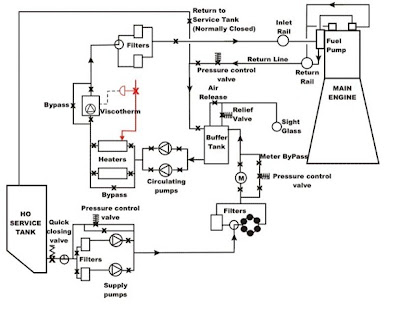5.3.1 Essential Components:
· Fuel Pump
· Fuel Injector
· Fuel Delivery Pipe
5.3.2 Fuel pump:
· Deliver a specific amount of fuel into cylinder through fuel delivery pipe and injector. The start and stop of fuel injection (with respect to crank angle), is determined at fuel pump.
5.3.3 Plunger controlled fuel pump Construction:
· Consist of housing, a plunger & barrel, a plunger return spring, a geared control sleeve and a control rack.
· The delivery valve assembly is mounted on top of housing. High pressure fuel discharged pipe is connected on delivery assembly.
· Cam-operated plunger moves in a reciprocating motion within the barrel.
· Plunger-spring pushes follower to maintain contact with cam.
5.3.4 Pumping principle:
· Fuel enters pump through inlet connection and fills fuel chamber surrounding the barrel.
· When plunger is at bottom of stroke, fuel flows through barrel ports (fills space above plunger, vertical slot cut in plunger and cut-away area below plunger helix)
· As plunger goes up, barrel ports are covered and compression begins.
· Fuel is discharged through lifted delivery valve into high pressure pipe.
· Fuel delivery stops when spill port is uncovered.
· Delivery valve returns to its seat and closes
· Rest of fuel is spilled backed into fuel chamber.
5.3.5 Function of fuel injector:
· Open and close the flow of fuel to combustion chamber
· Convert high pressure oil from pump, into fine spray
5.3.6 Construction:
· Consist of a valve body (which contains the spring and its compression nut). Mating surfaces between body and nozzle are ground and lapped to give a tight seal.
· Upper chamber in nozzle is charged with fuel and sealed by needle valve when closed. Lower chamber is sealed by the seat of needle valve and has many atomizing hole (atomise and distribute fuel spray into combustion chamber).
· A specific fuel pressure lifts the needle valve and oil flows to lower chamber. Additional area of needle mitre subjected to pressure and causes needle to lift rapidly (allow oil to pass through atomiser holes into combustion chamber at high pressures).
· Valves will close under spring compression once fuel pump cuts off pressure.

No comments:
Post a Comment